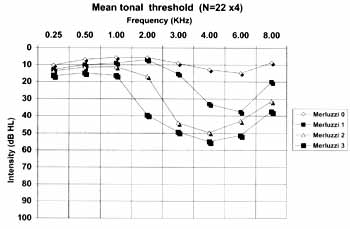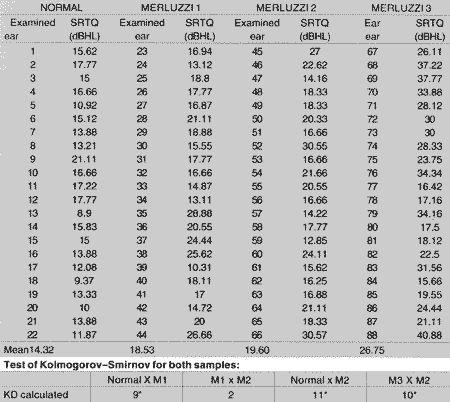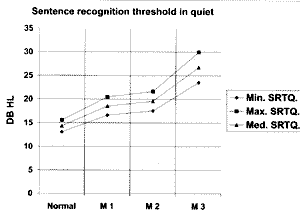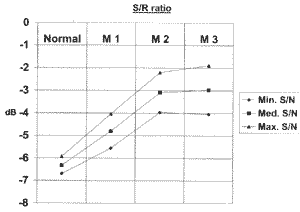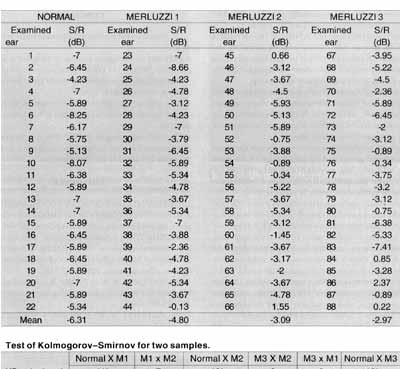

Year: 2000 Vol. 66 Ed. 4 - (8º)
Artigos Originais
Pages: 362 to 370
Recognition of Sentences in Silence and Noise in Individual Who Have Noise Induced Hearing Loss.
Author(s):
Pedro L. Coser*,
Maristela J. Costa**,
Maria J. S. Cóser***,
Yotaka Fukuda****.
Keywords: phonoaudiology, otolaryngology, hearing, audiology, audiometry, hearing deficiency, hearing loss, noise, competing noise
Abstract:
Introduction: Does noise induced hearing loss (NIHL) disturbs the every day communication of the individuals who have it? Does this disturbance occur in silence environments or just in noisy ones? Does it depends on the NIHL grade? Purpose: Evaluate the sentences recognition threshold, with and without competing noise, in individuals who has NIHL and compare their performance with normal ones. Material and method: We evaluated 88 ears, 22 with normal hearing, 22 with grade 1, 22 with grade 2 and 22 with grade 3, according to Merluzzi classification. All of them were submitted to anamnesis, ENT examination, pure tone audiometry and determination of the sentences recognition threshold in silence (SRTS), sentences recognition threshold in noise (SRTN) and the signal/noise ratio in which they were obtained, through headphones, following the ascending-descending strategy proposed by Levitt e Rabiner15, employing brazilian portuguese sentences developed by Costa7 in 1997. Conclusion: We concluded the recognition of sentences presented in silence and in the presence of competing noise are significant disturbed in individuals who has NIHL, showing a tendency to have a worse performance as the NIHL aggravates itself. We advise that this test should be added to the routine tests that evaluate the hearing handicap o€ this individuals to establish the real difficulties that they present in situations resembling the every day communication.
![]()
INTRODUCTION
Pure tone audiometry, essential for determining absence or presence of hearing loss, provides little information about the ability a subject with noise induced hearing loss WHO has to communicate in normal daily situations, since it presents artificial stimuli (pure tones) in an ideal environment (absence of background noise).
Normal life situations are normally associated with the presence of competitive noise. When speech is presented simultaneously to noise, subjects with or without normal hearing have more difficulty to listen to and recognize it. In mild to moderate hard-of-hearing subjects, this difficulty seems to be the main problem most of the time.
Therefore, it is important to assess the performance of subjects with NIHL in everyday communication situations, forcing the conduction of sentence recognition tests presented in quiet and in competitive noise in order to create a situation closer to normal life.
Since the first study by Fletcher, apud Glorig12, in 1929, suggesting that mean hearing thresholds in frequencies 500, 1.000 and 2.000 Hz would be indicators of the ability the subject had to hear everyday speech, new tests have been created. Add to it the statement by Kryter, Willians and Green14, in 1962, about the importance of hearing acuity higher than 2.000Hz to compensate speech, as well as the suggestion that the best stimuli to evaluate that ability would be meaningful sentences, with or without competitive noise consisting of speech acoustic spectrum.
The recent introduction by Costa7 of a new test of sentence recognition motivated the conduction of this study, in which for the first time in Brazil, we could observe the effects of NIHL in the comprehension of sentences in quiet and in noise.
MATERIAL AND METHOD
This study was conducted at the Service of Speech and Hearing Therapy, Universidade Federal de Santa Maria (UFSM), in which we conducted ENT and basic audiological assessments and carried out the test of sentence recognition in quiet and in noise, monaurally, using auricular phones. The Commission of Ethics of the Secretariat of Projects at CCS-UFSM approved this study.
The sample consisted of 66 examined ears of adult subjects who had noise induced hearing loss according to the criteria set by the American College of Occupational Medicine, Noise and Hearing Conservation Committee1. Twenty-two ears had Merluzzi17 grade 1 classification, 22 had grade 2 and 22 had grade 3. We decided to use Merluzzi's classification because it is the most widely used one in our country for occupational medicine purposes. As control group, we examined 22 ears without hearing loss. All patients were selected from 628 workers of Consorcio Ivai-Torno, a company building a hydroelectric plant in the city of Dona Francisca/RS.
Figure 1. Mean audiograms of examined ears of groups with normal hearing and hearing loss grades 1, 2 and 3 of Merluzzi's classification.
Mean audiograms of the 4 groups are showed in Figure 1.
All subjects were male, ranging in age from 19 to 50 years and homogeneously distributed in the groups. None of them had other hearing loss risk factors than exposure to noise.
The level of education of subjects was: 65.15% with incomplete fundamental school; in 22.72%, complete fundamental school; in 4.54%, incomplete high school, and in 7.57%, complete high school.
Subjects were submitted to anamnesis, otorhinolaryngologic assessment, pure tone audiometry in frequencies 250, 500, 1.000, 2. 000, 3.000, 4.000, 6.000 and 8.000 Hz, both air and bone conduction, speech recognition threshold for two-syllable words, speech recognition threshold for one-syllable words, and speech recognition for sentences in quiet and in noise, presented ipsilaterally, through auricular phones at the intensity of 65dBHL.
The anamnesis aimed at excluding from the sample subjects who had history of external and/or middle ear affections, or any other cause of hearing loss that not noise exposure. We also checked educational and social-cultural levels because according to Pereira20 they interfere in the responses patients give to speech recognition.
Visual inspection of ear canal and tympanic membrane was conducted in order to exclude from the sample subjects who had external and/or middle ear affections.
Measurements of this study were taken in acoustically treated environment, using Compact Disc Player Digital Toshiba - 4149, attached to a digital audiometer Fonix - Hearing Evaluator - model FA -12, type 1.
The sentence recognition test was conducted using the procedure proposed by Costa7 in 1997.
This material comprises 7 lists of 10 phonetically balanced sentences, recorded in compact disk. The lists are called 1B, 2B, 3B, 4B, 513, 6B, 7B. In the present study we did not use lists 5B and 7B, because according to Costa7, there are statistically significant differences in the measures obtained with these lists when compared to the others.
Next, we present the 5 lists used in the present study. 1 T.N. - The lists have not been translated because they are phonetically balanced in Portuguese language.
List 1B¹
1.) - O avião já esta atrasado.
2.) - O preço da roupa não subiu.
3.) - O jantar de sua mãe estava bom.
4.) - Esqueci de ir ao banco.
5.) - Ganhei um carro azul lindo.
6.) - Ela não esta com muita pressa.
7.) - Avisei seu filho agora.
8.) - Tem que esperar na fila.
9.) - Elas foram almoçar mais tarde.
10.) - Não pude chegar na hora.
List 2B
1.) - Acabei de passar um cafezinho.
2.) - A bolsa esta dentro do carro.
3.) - Hoje não a meu dia de folga.
4.) - Encontrei seu irmão na rua.
5.) - Elas viajaram de avião.
6.) - Seu trabalho estará pronto amanha.
7.) - Ainda não esta na hora.
8.) - Parece que agora vai chover.
9.) - Esqueci de comprar os pães.
10.) - Ouvi uma musica linda.
List 3B
1.) - Ela acabou de bater o carro.
2.) - É perigoso andar nesta rua.
3.) - Não posso dizer nada.
4.) - A chuva foi muito forte.
5.) - Os pregos subiram na segunda.
6) -. Esqueci de levar a bolsa.
7.) - Os pães estavam quentes.
8.) - Elas já alugaram uma casa na praia.
9.) - Meu irmão viajou de manhã.
10.) - Não encontrei meu filho.
List 4B
1.) - Sua mãe pós o carro na garagem.
2.) - O aluno quer assistir ao filme.
3.) - Ainda não pensei no que fazer.
4.) - Essa estrada a perigosa.
5.) - Não paguei a conta do bar.
6.) - Meu filho esta ouvindo música.
7.) - A chuva inundou a rua.
8.) - Amanha não posso almoçar.
9.) - Ela viaja em dezembro.
10.) - Você teve muita sorte
List 6B
1.) - Vou viajar as nove da manha.
2.) - Meu irmão bateu o carro.
3.) - Prometi a ele não contar o segredo.
4.) - Cheguei atrasada na aula.
5.) - Esta rua a perigosa.
6.) - Esqueci a bolsa na sua mesa.
7.) - Ela comprou os últimos pães.
8.) - A casa de campo já foi alugada.
9.) - Os preços não devem subir.
10.) - Não falei com sua filha.
Lists were recorded by a male professional narrator from the city of Sao Paulo.
Competitive noise used was developed by Costa, Iorio, Mangabeira-Albernaz, Cabral jr. and Magni8, and consisted of continuous speech spectrum noise, created in order to guarantee effective masking of the main speech signals.
Lists of sentences and competitive noise were presented through conventional auricular phones (TDH49). We decided to present the material like that because by doing so we could assess each ear individually and characterize the loss on each side, in addition to avoiding the typical problems of free field presentation (variable reverberation from one booth to the other; head position - if it moves during the test, the response may be different; need to occlude one ear if they are to be assessed individually; higher likelihood of having background noise influencing the test, and need to calibrate the sound produced by the louder speakers). This test format can also be applied in different audiology centers, because it simply requires a 2-channel audiometer and a regular acoustic booth.
Before starting each session of the test, we calibrated the output of each channel through VU-meter of the audiometer, and pure tone 1.000Hz was present in the same channel as the recorded sentences in CD, placed at level zero; the same was done for masking sound present in the other channel.
Sound pressure level in dBHL produced by the phones was obtained with the aid of a decibel meter brand BK type 4152 with microphone BK 4144 attached to an artificial ear. The reading of masking output, since it was an invariable sound, was done directly; on the other hand, reading of sentences output, since it was a variable intensity, was done one by one. We registered the highest intensity level of each of them and calculated their means, following the methodology proposed by Macleod and Summerfield16. Comparing values in dBHL of sentences in noise, in the same nominal intensity read by the audiometer, we noticed that the masking sound was recorded in the CD at a volume 7dB higher than the mean of the sentences. Therefore, we subtracted 7dB of the signal-to-noise ratio - S/N obtained for direct reading of nominal values of the audiometer at the end of each test. Values obtained in the audiometer for sentence recognition threshold in quiet were registered without correction.
The presentation of test material followed these procedures:
1.) - presentation of list 6B without background noise on the right so that the patient could become familiarized with the test;
2.) - presentation of list 6B in competitive noise ipsilaterally on the right ear, so that the patient could become familiarized with the test;
3.) - presentation of list 1B without competitive noise on the right;
4.) - presentation of list 2B in competitive noise ipsilaterally on the right ear;
5.) - presentation of list 3B without competitive noise on the left;
6.)-presentation of 4B in competitive noise ipsilaterally on the left.
The presentation of test material took approximately 10 minutes for each assessed subject.
We proceeded according to the procedure proposed by Levitt and Rabiner15. This procedure is called "sequential, adaptive or ascending-descending strategy" and enables determination of sentence recognition thresholds, that is, the necessary level to identify correctly about 50% of speech stimuli presented, both in quiet and in competitive noise, and the noise is presented at a constant intensity of 65 dBHL19,28.
The strategy was the following: we presented one sentence at initial intensity. If a correct response was given, we reduced intensity for the presentation of the next sentence. If the response was incorrect, the intensity of the next sentence was increased, keeping the intensity of noise always constant. The literature suggests that intervals of up to 4 dB should be used until the first change in response. From then on, presentation intervals should be of 2dB until the end of the list15. However, due to technical limitations of equipment, we used intervals of sentence presentation of 5 dB and 2.5dB, respectively.
A response was considered correct only if the subject repeated the complete sentence without mistake or omission.
We presented the first sentence of each list at the intensity similar to 2-syllable words SRT when evaluating sentence recognition thresholds in quiet (SRTQ) and 70dB when evaluating sentence recognition threshold in noise (SRTN). We increased or decreased the intensity for the presentation of the next sentence based on the response of the subject. During presentation of material, we recorded values in dBHL for the level in which each sentence was presented individually, and next we calculated a mean value of records, from the first change in response to the level in each the last sentence was presented; by doing so, we obtained sentence recognition threshold in quiet (SRTQ) and in noise (SRTN), according to the case. When we presented the list in competitive noise, we subtracted the SRTN from the noise intensity to obtain signalto-noise ratio (S/N). Therefore, it was characterized that S/N ratio is the difference in dB between the value of SRTN and the value of competitive noise.
Statistical method
In order to confirm the existence of statistically significant difference in SRTQ of subjects with normal hearing (control group) and those with hearing loss based on Merluzzi17, we used the test Kolmogorov-Smirnov, and marked statistically significant differences with an asterisk. We determined the level of rejection of null hypothesis as 0.05 (a = 0.05).The same procedure was followed to confirm the existence of different results obtained in the study of SRTQ among the groups in 3 different levels of hearing loss.
The same procedure was used for the study of S/N ratio.
RESULTS
Results are presented in Tables 1, 2, 3 and 4 and in Figures 2 and 3.
Analyzing the data, we observed that sentence recognition thresholds presented in quiet are significantly worse than those found in normal ear as from grade 1 of NIHL. These results did not show differences when compared to grade 2 results. Thresholds for grade 3 were the worst of them all (Tables 1 and 2, Figure 2).
We also noticed that S/N ratios obtained from sentence recognition thresholds in competitive noise were also worse than the values obtained for normal ears as from grade 1 of NIHL. In grades 2 and 3 S/N ratios were markedly worse than in grade 1, despite the fact that did not produce statistically significant differences (Tables 3 and 4, Figure 3).
DISCUSSION
Sentence recognition thresholds in quiet obtained for examined ears with normal hearing:
We observed that the arithmetical mean of SRTQ was 14.32 dBHL (13.06 dBHL to 15.58 dBHL).
In the literature, we found the values 19 dBHL23,13.5 dBHL10, 16 dBHL22 and 15.88 + 2,3 dB 21 for SRTQ, when material was presented through auricular phones or in free field, monaurally and frontally.TABLE 1 - Sentence recognition threshold in quiet of normal subjects and those with NIHL grades 1, 2 and 3 of Merluzzi.
Table L - to n=22, KD=9, level of significance of 5%.
We also found values of 26.8 dBHL3, 23.91 dBHL18,17.15 dBHL8, 32.9 dBHL13 and 22.90 to 24.47 dBHL" for SRTQ when the material was presented binaurally in free field.
Therefore, it is evident that results obtained in our study were very similar to the ones found in the literature, provided that the test material was presented through auricular phones or monaurally in free field. The minor differences we found could be due to differences in calibration of speech signals.
Sentence recognition thresholds in quiet obtained for examined ears with NIHL in grades 1, 2 and 3 of Merluzzi:
We observed that the calculated arithmetical mean of SRTQ was 18.53 dBHL (16.60 to 20.46 dBHL), 19.60 dBHL (17.55 to 21.64 dBHL) and 26.75 dBHL (23.54 to 29.96 dBHL), in groups 1, 2 and 3, respectively.
Plomp22 observed that the mean for SRTQ was 23.9 + 5.2 dBHL in one group of 53 patients with NIHL, but he did not assess its modifications as a result of progression of hearing loss.
Smoorenburg22 observed that SRTQ varied from 14.6 to 31.4 dBHL in a group of 400 examined ears of subjects exposed to occupational noise, and many of them had normal hearing levels, whereas others had different degrees of NIHL.
Comparing our results to the studies mentioned above, the only two studies found in the international literature - since in Brazil there is no study about NIHL and SRTQ, we observed that data were consistent among the three and none of the two international studies related SRTQ alterations to degree of loss.
Figure 2. Sentence recognition threshold in quiet (dBHL) mean, minimum and maximum (confidence intervals of 95%) for examined ears with normal hearing and noise induced hearing loss grades 1 (M 1), 2 (M 2) and 3 (M 3).
Figure 3. S/R ratio (dB) mean, minimum, maximum (confidence intervals of 95%) for the study of SRTN in examined ears with normal hearing and noise induced hearing loss grades 1 (M 1), 2 (M 2) and 3 (M 3).
TABLE 2 - Descriptive statistics of SRTN in normal subjects and those with NIHL rades 1, 2 and 3 of Merluzzi.
Eo = semi-amplitude of confidence interval; X= 5%.
Statistical comparison among results of SRTQ obtained in examined ears with the 3 grades of NIHL and the results obtained in examined normal hearing ears, described in Tables 1 and 2 and illustrated in Figure 1, clearly showed that they were significantly higher han normal in the 3 grades of NIHL.
SRTQ of groups grade 1 and 2 of Merluzzi did not differ one from the other. SRTQ of grade 3, however, had a statistically significant difference from the other 3 groups. We may state that SRTQ is higher in grades 1 and 2 than in normal subjects; in addition, results are much worse if the hearing loss reaches Merluzzi grade 3.
S/N ratio obtained in normal hearing examined ears:
After determining SRTQ with Lists 2B and 4B, we calculated S/N ratio by subtracting the determined value of noise. Arithmetical mean calculated for S/N ratio of normal hearing examined ears was - 6.31 dB ( -6.69 to - 5.93 dB) (Tables 3 and 4, Figure 3).
In the literature, we found the following S/N ratio in normal hearing subjects - 5.4 dB23, - 6.2 Db10 - 5.8 dB10, - 5.0 dB29, - 5.5 dB 21 and - 5.1+1.8 dB27, when material was presented through auricular phones or in free field, monaurally and frontally.
We also found the values of -11 dB30, -6.4 dB3, - 7.2 dB4, - 2.92 dB18, -11 dB8, -12 dB13, -11 dB7, -12.85 dB25 and - 6.99 to - 6.50 dB21, when the material was presented, as a binaural test in free field or in dichotic presentation with phones18.
Based on the studies mentioned above, it is clear that the results obtained by the present paper were very close to the literature, provided that the test material was employed through auricular phones or monaurally in free field. The minor differences we found may be due to differences in calibration of speech and/or noise signals.
S/N ratio obtained in examined ears with NIHL in grades 1 2 and 3 of Merluzzi:TABLE 3 - Signal/noise ratio obtained in normal subjects and NIHL grades 1, 2 and 3 of Merluzzi in sentence recognition threshold in noise.
Table L - to n=22, KD=9, with significance level of 5%
TABLE 4 - Descriptive statistics of S/N ratio in subjects who are normal and who have NIHL
Eo = semi-amplitude of interval of confidence; X=5%.
After SRTQ with Lists 2B and 413, we calculated S/N ratio. Arithmetical mean calculated for S/N ratio of examined ears with NIHL grades 1, 2 and 3 of Merluzzi were -4.80 dB(- 5.56 to - 4.03 dB), -3.09 dB (-3.97 to - 2.20 dB) and -2.97 dB(- 4.05 to - 1.89 dB), respectively (Tables 3 and 4, Figure 3).
Plomp22 found S/N ratio of - 2.7 dB (- 4.7 to - 0.7 dB) in a group of 53 people with NIHL, without assessing the modifications of S/N ratio as a result of progression of hearing loss. Therefore, the author found a mean worsening of 2.8 dB, going up to 4.8 dB, in relation to the normal group.
Smoorenburg27 found S/N ratio that varied from- 5.09 to - 0.1 dB in a group of 400 examined ears of workers exposed to occupational noise, and many of them had normal hearing, whereas the others had NIHL. The author found worsening of up to 4.98 if compared to normal subjects.
Our results produced a worsening between the mean value of the normal group and the mean value of the three groups with NIHL of 2.7dB, varying from 1.88 to 4.80 dB.
Based on the data presented here, we could see that our study and the literature were perfectly consistent.
In order to fully understand the effect of a poor S/N ratio over the ability to comprehend speech in noisy environment, it is necessary to take into account that there is a difference of only 10 dB between comprehension of 0% of the sentences and 100%, as from the intensity that the sentences started to be played. In addition, there is an increase of 1dB in the intensity of sentences close to the sentence recognition threshold, which corresponds to an increase of 18% in comprehension. In other words, a subject with worsening of 4dB in S/N ratio, compared to a normal one, would understand only 15% of the sentences presented at the same intensity level in which a normal subject would understand 82%. A subject with a S/N ratio of 2.5dB worse than another one should be positioned 75cm from the sound source to have the same comprehension of the other placed 100cm from the sound source27.
Other authors5,11,24,6 observed the negative effects of NIHL in the ability of perceiving one and two-syllable words in noise; however, their methodology is different and it is not possible to conduct direct quantitative comparison of results. From a qualitative point of view, there is consistency among the data, because they reached the same conclusions - that speech perception in competitive noise for people with NIHL is worse than in normal subjects.
Statistical comparison of results of S/N ratio obtained in examined ears with the 3 grades of NIHL and normal hearing ears, described in Tables 3 and 4 and illustrated in Figure 3, shows that they are significantly higher than normal in the 3 grades of NIHL.
S/N ratios were markedly larger for grades 2 and 3 of Merluzzi than for grade 1, but not statistically significant, suggesting that the impairment of recognizing sentences in noise with Merluzzi grade 1 is present, but it is accentuated in grade 2 and then maintained in grade 3.
CONCLUSION
Based on the results of the present study we concluded that:
o Difficulty to recognize sentences in quiet is significantly present in NIHL grade 1 of Merluzzi's classification.
o This difficulty is maintained in grade 2 and becomes significantly worse in grade 3.
o The difficulty to discriminate sentences in competitive speech spectrum noise is significant in NIHL since grade 1 of Merluzzi.
o This difficulty, despite the fact that it is in average more significant as the noise induced loss progresses, is not changed in grades 1, 2 and 3 of the classification.
REFERENCES
1. AMERICAN COLLEGE OF OCCUPATIONAL MEDICINE, NOISE AND HEARING CONSERVAT10N COMMITTEE-Occupational noise-induced hearing loss. J. Occup. Med., 31:996, 1989.
2. BOOTHROYD, A.-Speech perception, sensorineural hearing loss, end hearing aids. In: STUDEBAKER, G. & HOCHBERG, I. - Acoustical factors affecting hearing aid performance. 2 ed. Boston, Allyn & Bacon, 1993. P. 277-99.
3. BRONKHORST, A. W. & PLOMP, R. - A clinical test for the assessment of binaural speech perception in noise. Audiology, 29: 275-85, 1990.
4. BRONKHORST, A. W. & PLOMP, R. - Effect of multiple speech-like maskers on binaural speech recognition in normal and impaired hearing. J. Acoust. Soc. Am., 92 (6):3132-9, 1992.
5. COOPER, J. C. & CUTTS, B. P. - Speech discrimination in noise. J. Speech Hear. Res., 14: 332-7, 1971.
6. COSTA, E. A. - Estudo da correlação entre a audiometria tonal e o reconhecimento de monossílabos mascarados por fala competitiva nas perdas auditivas induzidas pelo ruído. [DISSERTAÇÃO DE MESTRADO, PUC/SP] São Paulo, 1992.
7. COSTA, M.J - Desenvolvimento de listas de sentenças em português. [TESE DE DOUTORADO, UNIVERSIDADE FEDERAL DE SÃO PAULO]. São Paulo, 1997.
8. COSTA, M. J.; IORIO, M.C.M.; MANGABEIRA-ALBERNA2, P.L. - Reconhecimento de fala: desenvolvimento de uma lista de sentenças em português. Acta Awho,16(4): 164-73,1997. .
9. COSTA, M. J; IORIO, M.C.M.; ALBERNAZ, P.L.M.; CABRAL Jr., E.F.; MAGNI, A.B. - Desenvolvimento de um ruído com espectro de fala. Acta Awho,17(2): 84-9, 1997.
l0. DUQUESNOY, A J. & PLOMP, R. - The effect of a hearing aid on the speech-reception threshold of hearing-impaired listeners in quiet and in noise. J. Acoust. Soc. Am., 73 (6) : 2166-73, 1983.
11. FINDLAY, R. C. -Auditory dysfunction accompanying noise induced hearing loss. J. Speech Hear. Dis., 41:374-80, 1976
12. GLORIG, A. - Compensation for industrial hearing loss: the practice in the United States. In: Beagley, H. A. - Audiology, and Audiological Medicine. Oxford. Oxford U. P.,1981. P. 86179.
13. KRAMER, S. E.; KAPTEYN, T. S.; FESTEN, J. M. & KUIK, D. J. -Assessing aspects of auditory handicap by means of pupil dilatation. Audiology, 36 (3): 155-64, 1997.
14. KRYTER, K.D.; WILI.IANS, C.; GREEN, D.M.-Auditory acuity and the perception of speech. J. Acoustic. Soc. Am., 34:1217-23, 1962.
15. LEVITT, H. & RABINER, L.R., - Use of a sequential strategy in intelligibility testing. J. Acoust. Soc. Am., 42: 609-12, 1967.
16. MCLEOD, A. & SUMMERFIELD, Q. - A procedure for measuring auditory and audio-visual speech reception thresholds for sentences in noise: rationale, evaluation and recommendations for use. Br. J. Audiol., 24: 1085-99,1994.
17. MERLUZZI, F.; PARIGI, G.; CORNACHIA, L.; TERRANA, T. - Metodologia di esecuzione del controllo dell'udito dei lavoratori esposti a rumore. Nuovo Arch. Ital. Otol., 7695-712, 1979.
18. NILSSON, M j.; SOLI, S.D.; SULLIVAN, J. - Development of the hearing in noise test for the measurement of speech reception threshold in quiet and in noise. J. Acoust. Soc. Am., 95: 108599, 1994.
19. NILSSON, M J.; SOLI, S.D.; SUMIDA, A - Development of norms and percept inteltigibility functions for the HINT. House Ear Institute, Feb. 1995.
20. PEREIRA, L. D. - Audiometria verbal. Teste de discriminação vocal com ruído. [TESE DE DOUTORADO, UNIVERSIDADE FEDERAL DE SÃO PAULO]. São Paulo, 1993.
21. PAGNOSIN, D. - Reconhecimento de sentenças em campo livre em indivíduos portadores de perda auditiva neurossensorial. [TESE DE MESTRADO- UNIVERSIDADE FEDERAL DE SANTA MARIA] Santa Maria, 1999.
22. PLOMP, R.,-A signal-to-noise ratio model for the speech reception threshold of the hearing impaired. J. Speech Hear.Res.29: 146-54,1986.
23. PLOMP, R. & MIMPEN, A.M. - Speech-reception threshold for sentences as function of age and noise level. J-Acoust. Soc. Am. 66(5): 1333-42, 1979.
24. QUIST-HANSSEN, Sv.; THORUD, E. & AASAND, G.- Noise induced hearing loss and the comprehension of speech in noise. Acta otolaryng. Suppl. 360: 90-5, 1979.
25. SCHARLACH, R. C. - Estudo comparativo do desempenho de proteses auditivas com circuito K- Amp a limitação por compressão. São Paulo, 1998. [TESE DE MESTRADO, UNIVERSIDADE FEDERAL DE SÃO PAULO - ESCOLA PAULISTA DE MEDICINA].
26. SCHOCHAT, E. - Percepção de fala. In: Processamento auditivo. São Paulo, Lovise, 1996. (Atualidades em fonoaudiologia; v. 2).
27. SMOORENBURG, G. F. - Speech reception in quiet and in noisy conditions by individuals with noise-induced hearing loss in relation to their tone audiogram. Acoust. Soc. Am., 91(1):421-37, 1992.
28. SOLI, S.D. & NILSSON, M. -Assessment of communication handicap with the HINT. Hear. Instrum., 45(2): 14-6, 1994.
29. SUTER, A. - Speech recognition in noise by individuals with mild hearing impairments. J. Acoust. Soc. Am. 78(3): 887-900, 1985.
30. WELZL - MOLLER, K. & SATTLER, K. - Signal-to-noise threshold with and without hearing aid. Scand. Audiol., 13: 2836, 1984.
* Joint Professor of Otorhinolaryngology at UFSM..
** Joint Professor of Audiology at UFSM.
*** Otorhinolaryngologist at Hospital Universitário UFSM.
**** Joint Professor, Post-Ph. D. in Otorhinolaryngology at UNIFESP-EPM.
Doctorate dissertation in Human Communication Disorders presented on December 10, 1999 at UNIFESP-EPM, São Paulo /SP
Address for correspondence: Pedro Luiz Coser - Rua Duque de Caxias, 1668/304 - 97015-190 Santa Maria /RS - Tel: (55-55) 223-7850 - Fax: (55-55) 221-9784.
E-mail: coserpl@ccs.ufsm.br
Article submitted on February 25, 2000. Article accepted on May 25. 2000.
